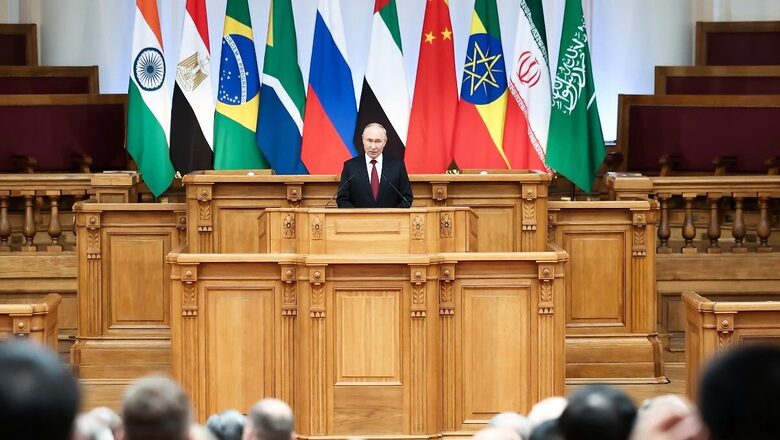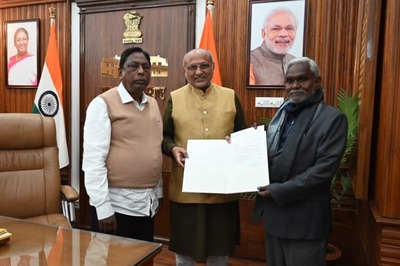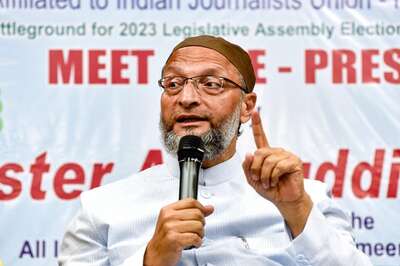
views
Russian President Vladimir Putin will be hosting over a dozen leaders from around the world, including the BRICS Plus partners, in Kazan from October 22-24 for the XVI BRICS Summit, after having organised hundreds of meetings of various sectoral groups across a wide spectrum. While the Western world may view BRICS Plus as an anti-Western outfit, President Putin recently quoted PM Narendra Modi in affirming its nature and objectives, stating that “BRICS is not anti-West but non-West.” He also asserted that the Russian 2024 BRICS Chairmanship, under the motto ‘Strengthening Multilateralism for Just Global Development and Security’, will act in this spirit, focusing on positive and constructive cooperation with all concerned countries.
However, the summit is taking place at a critical juncture, with the global landscape heavily fractured. The simultaneous impacts of the Eurasian and Middle Eastern wars, along with the lingering effects of the pandemic, continue to make life in the Global South even more difficult. BRICS offers an alternative forum for these nations and potentially aligns with their aspirations. The Russian Presidency’s priority is to seamlessly and harmoniously integrate the association’s new members into the BRICS framework; develop modalities for interaction with BRICS partner countries; and enhance the efficiency of the international relations system, ensuring its further democratisation.
President Putin emphasised that “BRICS is attracting an ever-increasing number of supporters and like-minded countries that share its underlying principles: sovereign equality, respect for each nation’s chosen path of development, mutual consideration of interests, openness, consensus, the aspiration to form a multipolar international order and a fair global financial and trade system, and the pursuit of collective solutions to the top challenges of our time.” It is no surprise, then, that after the first phase of expansion in Johannesburg, 34 countries have expressed interest in joining the group, which attests to its efficacy and potential, at least as perceived by the Global South. In the geo-economic context, BRICS is indeed poised to emerge as a powerful collaborative pole within the emerging global power matrix.
One of the major outcomes of the Russia-Ukraine war has been the weaponisation of financial instruments by the West, especially the US, which cut Russia out of the SWIFT system and confiscated nearly $360 billion of Russian funds held in Western banks and financial institutions, even using the interest accrued to divert funds to Ukraine. This was seen as a significant red line by Russia and created a crisis of confidence for the rest of the world. Speaking to the media from BRICS countries ahead of the summit, President Putin lamented, “We did not drop the dollar — it is a universal currency, but we were banned and barred from using it. Now, 95 per cent of Russian external trade is denominated in national currencies.”
Most countries, led by China, Russia, and India, have begun to diversify their currency risks, increasingly preferring trade transactions through bilateral currency mechanisms. India alone has signed UPI (Unified Payments Interface) agreements and introduced RuPay cards in over two dozen countries. In fact, most recently, India extended a line of credit designated in rupees to Mauritius — a first for the country.
Russia, China, and several other nations have developed their own currency and settlement mechanisms, gradually leading to de-dollarisation. BRICS Plus countries are now exploring the establishment of a new reserve currency backed by a basket of their respective currencies. At Kazan, leaders are expected to continue discussions on creating a potentially gold-backed currency as an alternative to the US dollar, and are likely to announce the way forward on this critical issue.
A potential BRICS currency would allow these nations to assert their economic independence while competing with the existing international financial system. The current system is highly dependent on the US dollar, which accounts for a lion’s share of global trade. Until recently, nearly 100 per cent of oil trading was conducted in US dollars. However, in 2023, one-fifth of all such trades were reportedly carried out using non-US dollar currencies, particularly the yuan, rouble, and even the rial and dirham. This diversification makes sense, as transaction costs and financial dependencies can undermine national sovereignty. Nonetheless, any new system will need to address inherent concerns and challenges.
The BRICS consortium has numerous reasons for wanting to establish a new currency. The current global political and geopolitical landscape — including the Russia-Ukraine war, financial challenges, and an aggressive US stance on foreign policy, particularly wide-ranging sanctions and the economic boycott of Russia — has prompted BRICS countries to explore this possibility. The BRICS nations aim to better serve their own economic interests while reducing global dependence on the US dollar and the euro. For decades, the US dollar has enjoyed dominance as the world’s leading reserve currency. According to the US Federal Reserve, between 1999 and 2019, the US dollar was used in 96 per cent of international trade invoicing in the Americas, 74 per cent in the Asia-Pacific region, and 79 per cent in the rest of the world.
There is no definitive launch date yet, but the countries’ leaders have discussed the possibility. Russian President Vladimir Putin has stated that the BRICS countries plan to issue a “new global reserve currency” and are ready to work openly with all fair-trade partners. In April 2023, Brazilian President Luiz Inácio Lula da Silva, currently chairing the G20, voiced his support for a BRICS currency, commenting, “Why can’t an institution like the BRICS bank have a currency to finance trade relations between Brazil and China, between Brazil and all the other BRICS countries? Who decided that the dollar was the trade currency after the end of gold parity?”
Whatever form it takes, it will need to be a neutral BRICS currency, digital or otherwise, with combined financial strength and a robust settlement mechanism to address intra-BRICS trust deficits. For example, India has been settling its oil payments with Russia in rupees or even dirhams, but has declined to settle outstanding dues in yuan due to its own geo-economic considerations.
A new currency could offer several benefits for the BRICS countries, including more efficient cross-border transactions and increased financial inclusion. By leveraging blockchain technology, digital currencies, and smart contracts, such a currency could revolutionise the global financial system. With seamless cross-border payments, it could also promote trade and economic integration among BRICS nations and beyond, while mitigating risks associated with global volatility caused by unilateral measures and reducing dependence on the dollar. “We believe that creating an independent BRICS payment system is an important goal for the future, which would be based on state-of-the-art tools such as digital technologies and blockchain. The main thing is to ensure it is convenient for governments, common people, and businesses, as well as cost-effective and free of politics,” Kremlin aide Ushakov stated in an interview with Russian news agency TASS.
While BRICS nations do not yet have their own specific digital currency, a BRICS blockchain-based payment system is reportedly in the works, according to Ushakov in March 2024. Known as the BRICS Bridge multisided payment platform, it would connect member states’ financial systems using payment gateways for settlements in central bank digital currencies. This planned system would serve as an alternative to the current international cross-border payment platform, the Society for Worldwide Interbank Financial Telecommunication (SWIFT) system, which is dominated by US dollars. However, the impact of a new BRICS currency on the US dollar will depend on its adoption, perceived stability, and the extent to which it can offer a viable alternative to the dollar’s longstanding hegemony. This process will take time and require a concerted effort from all BRICS members to ensure that each feels duly invested and rewarded.
In any case, the BRICS summit has a broad agenda, addressing numerous regional and global issues, including the challenges facing the Global South, such as food and energy security. India is a key founding member and pivotal player in BRICS, and PM Modi’s visit to Russia twice within a span of four months underscores the importance New Delhi attaches to the BRICS.
Amb Anil Trigunayat is a former Indian Ambassador; Dr Anil Pandey is an Asst Professor at Chennai University. The views expressed in the above piece are personal and solely those of the author. They do not necessarily reflect News18’s views.




















Comments
0 comment